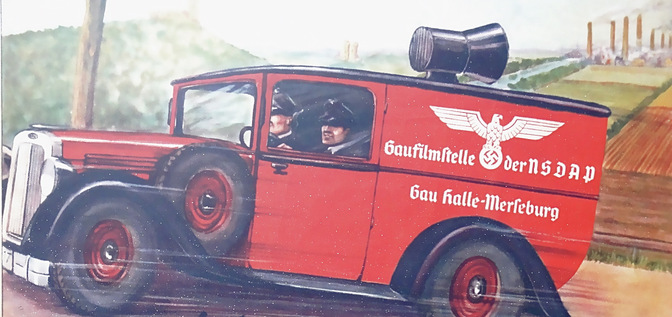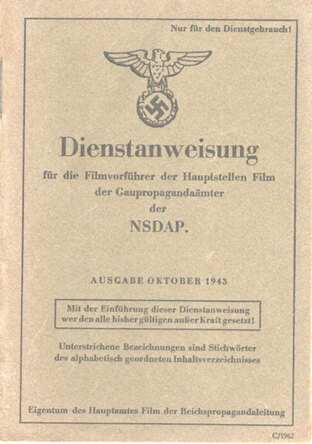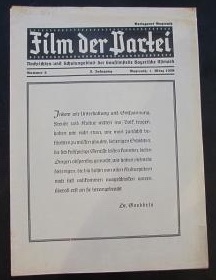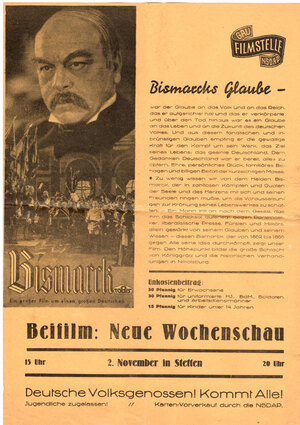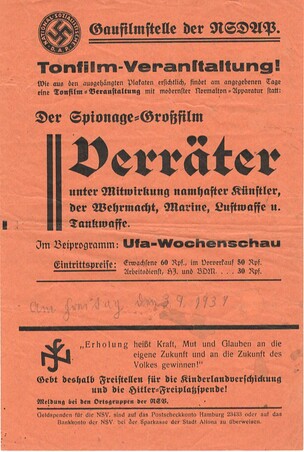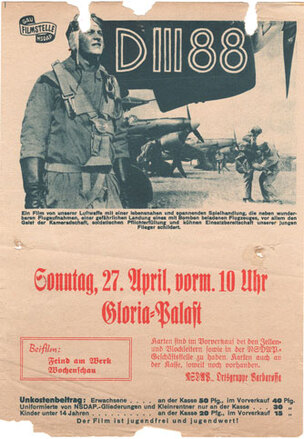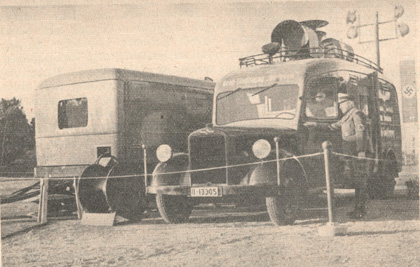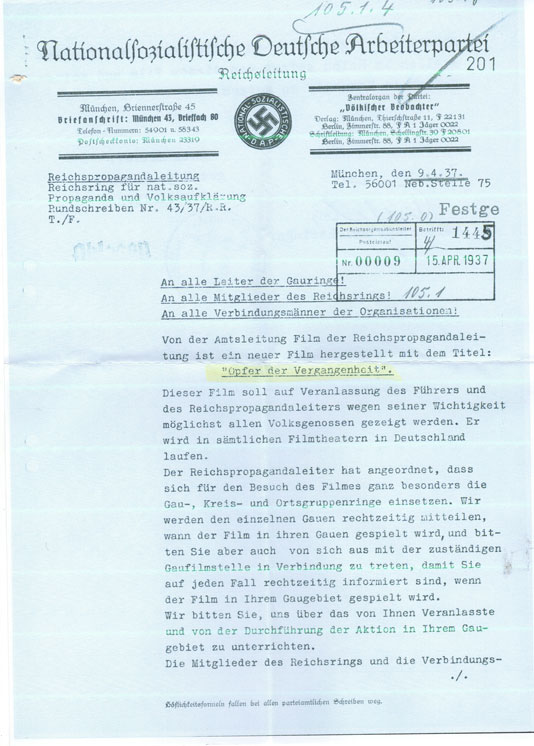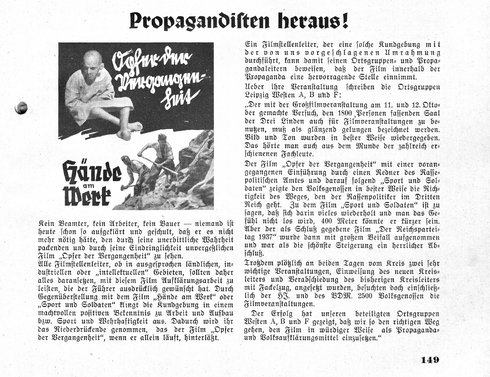- Home
- POSTER GALLERY
- ❗️BOOK & POSTER STORE❗️
- PURCHASE "HJ Quex" film ephemera HQ
- About the Posters
- The William Gillespie Collection
- Our Publishing House
- ❗️GFDN interviews author and collector William Gillespie ❗️
- Our most expensive & inexpensive finds!
- ❗️***NEW!**❗️POSTER OF THE MONTH - Blutzeugen / Raza
- ❗️NEW ❗️Film Posters – Demands on an important means of film advertising. ❗️
- In our Book + Zeitschrift Library
- ❗️ ***NEW!*** Hitler Youth Quex – A Guide for the English–speaking Reader ***NEW!*** ❗️
- ❗️***NEW!*** Table of Contents of our new HJ QUEX book❗️
- ❗️Hitler Youth Quex Guide - early praise! ❗️
- Recent loans from the Collection
- Farewell Horst Claus. (1940–2024 †)
- "Der Deutsche Film" Zeitschrift
- ❗️ ***NEW!***Reichsfilmkammer collection ❗️
- German "Tendency" Films (Tendenzfilme) in the Third Reich
- KARL RITTER
- Karl Ritter original film posers in this Collection
- "Besatzung Dora" ( † 1943)
- "The Making of The Crew of the Dora"
- Karl Ritter at the 1938 Reichsfilmkammer Congress
- INDEX -"Karl Ritter" book, 2nd edition
- Karl Ritter's Legion Condor (1939, unfinished)
- Excerpt from our "Dora" book
- ∆∆∆∆∆ High praise for our DORA book! ∆∆∆∆∆
- TABLE OF CONTENTS – "Legion Condor"
- § § § § § Early Praise for our LEGION CONDOR book! § § § § §
- ❗️"Das Leben geht weiter" and Karl Ritter ❗️
- Dateline: Ufa - April 11, 1945
- Zarah Leander Europe–wide !
- Japan Military Film and Karl Ritter
- Karl Ritter after 1945
- 1935 Film Congress
- Poster Exhibition in Berlin, March 1939
- Potsdam poster exhibition 12 April–25 August 2019
- Leni Riefenstahl's two "Olympia" Films (1938)
- "Ohm Krüger" (1941)
- Emil Jannings
- "Blutendes Deutschland" (1933)
- Hannes Stelzer ( † 1944)
- Klaus Detlef Sierck ( † 1944)
- Film stills
- Reich Film Censorship Offices
- ❗️***NEW!***The Fate of the German Film Industry in May 1945 ❗️
- Film censorship cards
- Film Archives
- Cinema advertising
- School filmstrips
- ❗️UPDATED❗️ Z F O / Ostland Film G-m-b-H
- Z F O / Herbert Jacobi estate
- ZFO / Ostland Film newspaper articles
- ❗️***NEW!*** Roter Nebel / Red Fog / Red Mist (1942/1943, ZFO) ❗️
- ZFO - Der Rückkehrer - The Returnee (1943/1944)
- The D F G production company
- D I F U
- ❗️ ***NEW!*** "Carl Peters" – Special Collection. ❗️
- "Alcazar" (1940, Genina)
- "Der 5. Juni" (1943, banned)
- Herbert Selpin and his "Titanic" (1943)
- Ein Robinson (1940, Fanck)
- "Fronttheater" (1942)
- Veit Harlan's Jud Süß and Fritz Hippler's Der Ewige Jude
- Harlan "Jud Süß" trial 1949
- Werner Krauss & JUD SÜß
- Anti-Semitic Film Posters in the Collection
- "Heimkehr" (1941)
- "Hitlerjunge Quex" (1933)
- ❗️***NEW!*** Hitlerjunge Quex in 111 Greater Berlin Cinemas ❗️
- Jürgen Ohlsen
- "S.A.Mann Brand" (1933)
- "In der roten Hölle" (Edgar Neville, 1939)
- "Helden in Spanien" (1938)
- The Spanish Civil War in Film
- Andrews Engelmann (1901 – 1992)
- Deutsche Wochenschau
- Uƒa Feldpost
- Uƒa Kulturfilm – Informationen
- " Die Tochter des Samurai" (1937, Fanck)
- Ufa 25th Anniversary
- Invitations to world premieres
- ❗️***NEW!*** Continental Films, Paris 1940–1944 ❗️
- Film Censorship in Occupied Paris 1942
- "Der Sieg des Glaubens" (1933)
- Wilhelm Althaus Estate
- Weimar Germany posters
- Ufa and the Ordensburgen
- The Gaufilmstelle in our Collection
- "Zwei Welten" (1940)
- "Capriccio" (1938) –Karl Ritter film album
- Unrealised NS Propaganda Films 1934–1945
- German Film Directors accused of "war crimes"
- Australian––themed NS feature films
- "Der Störenfried" / "The Troublemaker"
- What was new in 2014?
- What was new in 2015?
- What was new in 2016?
- What was new in 2017?
- What was new in 2018?
- What was new in 2019?
- What was new in 2020?
- What was new in 2021?
- What was new in 2022?
- What was new in 2023 ?
- What's new in 2024?
- ❗️***NEW!*** Hitler assassination attempt in Karl Ritter film cut❗️
- BESATZUNG DORA private photos
- Just discovered 1942 article on BESATZUNG DORA
- The Karl Ritter Tetralogy
- Google Analytics 2023
- Our first–ever acquisition!
- ❤️"Some of our favourite things....!"❤️
- ERRATUM for our " Hitler Youth Quex Guide"
- Trending
- Vale †
- Our Wants List / 2024 / Wunschliste
- Pop Quiz
- Unsere KARL RITTER Bücher in Deutschland liefbar!
- WHERE to buy our books right now?
- ✉️Contact
 “History is not about the facts. It is about the context and who is telling the story.” —Prof. Milton Fine.
“History is not about the facts. It is about the context and who is telling the story.” —Prof. Milton Fine.
"Who controls the past controls the future: who controls the present controls the past." –– George Orwell in his novel "1984."
"Whoever doubts the exclusive guilt of Germany for the Second World War destroys the foundation of post–war politics." –– Prof. Theodor Eschenberg, Rector, the University of Tübingen.
"If we have our own why in life, we shall get along with almost any how." – Friedrich Nietzsche
POSTER GALLERY --view
over 500 German film
original posters between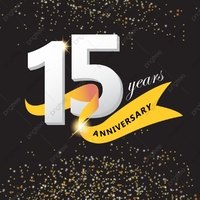
1927–1954 from
Germany and from
many Axis and Neutral countries
across Europe!
Note! Posters in the Poster Gallery are PERMANENT
acquisitions which are NOT FOR SALE!! ONLY the
posters listed in our POSTER STORE are for sale.
(They have a price and order button to use.)
The Gaufilmstelle materials in our Collection
The Gaufilmstelle were the regional film distribution offices spread throughout Greater Germany and also in Occupied Poland and in the Protektorat of former Czech lands. They were part of the extensive propaganda network of the NSDAP.
In the 2003 book Ein Volk, ein Reich, ein Kino (Kleinhaus, Bernd; PapyRosa Verlag, Köln, pp.164 ff.) the following facts about the Gaufilmstelle organisation are spelled out:
The NSDAP was keen to bring movies to the rural and farming areas, as some 23 million Germans, or roughly a quarter of the nation, lived where there were no cinemas. (Farmers and country folk were strong supporters of Hitler and his agrarian policies, including the laws which forbade money lenders or banks foreclosing on farms held for generations of German families.)
In 1935, there were a total of 227 mobile cinema trucks (Tonfilmwagen) being employed. By 1941 and through to war's end, there were a grand total of 835 Tonfilmwagen.
In the 1935 book Der Film in Staat und Partei (Belling, Curt; Velag Der Film, Berlin) an illustration symbolises the network of these Gau-Kries-Ort Filmstellen as of that time:
Gau = District
Kreis = Circuit, Circle
Ort = Place, Location (i.e. town, village, hamlet)
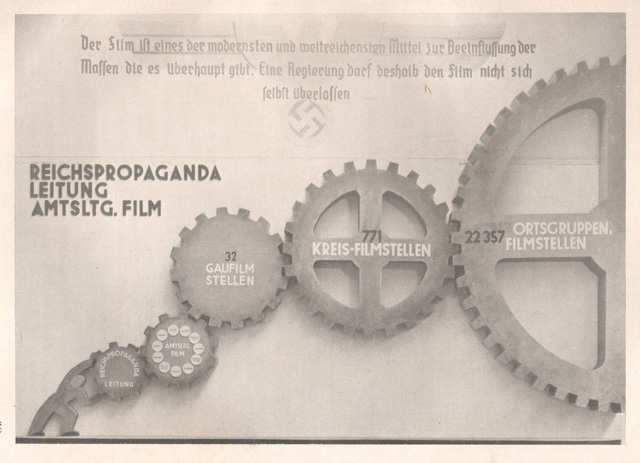
The book states that as of 1935, "more than 600" employees were working for the Gaufilmstelle across the Reich.
The Gaufilmstelle over the years reached thousands of towns and villages whose inhabitants had to a great extent never experienced watching a motion picture previously. In his 1940 book Die Werbung für den Deutschen Film durch den Einsatz publizistischer Führungsmittel, Dr. Harald Walter gives one example of the red Gaufilmstelle truck which visited the village of Kurtschau near Gommla in the Gau of Thuringia in central Germany. Of 245 inhabitants, 40 had never seen any motion picture previously, and 100 had never seen a sound film before. That was in November 1937. (Walter, S. 28).
By the time of the Anschluß of Austria and the incorporation of the Sudenten lands into the Reich, three years later, there were 40 Gaufilmstelles (Districts), 771 Kreisfilmstelles (Circuits) and 22,357 Ortsfilmstelle (Places) in the Reich.
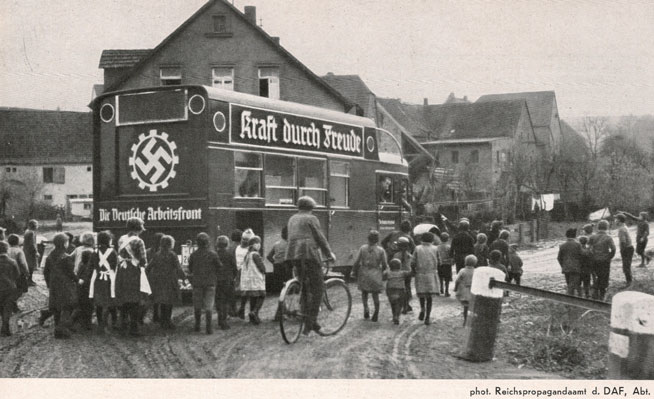
Each Gau or District/Region had its own film publication, as per this list found on the Internet:
• Film und Bild. — Halle (Saale): NSDAP., Gaufilmstelle Halle-Merseburg.
• Film und Foto. — Dresden: NSDAP., Gaufilmstelle Sachsen.
• Film der Partei, Nachrichten- u. Schulungsblatt d. Gaufilmstelle Bayer, Ostmark. — Bayreuth: Gauverl. Bayer. Ostmark.
• Film in Partei und Gliederungen. — Halle (Saale): NSDAP., Gaufilmstelle Halle-Merseburg.
• Film in Partei und Schule. — Halle (Saale): NSDAP., Gaufilmstelle Halle-Merseburg.
• Der Film in Partei und Staat. — Berlin: NSDAP., Reichspropagandaleitung, Amtsleitung Film.
• Filmdienst. — Hannover: NSDAP., Gaufilmstelle Südhannover-Braunschweig.
• Filmdienst der Gaufilmstelle Düsseldorf der NSDAP. — Düsseldorf: NSDAP., Gaufilmstelle Düsseldorf.
• Filmdienst der Gaufilmstelle Koblenz-Trier. — Koblenz: NSDAP., Gaufilmstelle Koblenz-Trier.
• Filmdienst der NSDAP., Gaufilmstelle Köln-Aachen. — Köln: NSDAP., Gaufilmstelle Köln-Aachen.
• Film-Echo, Nachrichtenblatt d. Gaufilmstelle Schlesien. — Breslau: NSDAP., Gaufilmstelle Schlesien.
• Film-Nachrichten der Gaufilmstelle Württemberg-Hohenzollern der NSDAP. — Stuttgart: NSDAP., Hauptstelle Film.
• Film-Nachrichten - Mitteilungsblatt für den gesamten Bereich des deutschen Filmschaffens
• Filmpropaganda. — Dresden: NSDAP., Gaufilmstelle Sachsen.
• Nationalsozialistische Filmpropaganda. — Berlin: NSDAP., Gaufilmstelle Kurmark.
• Deutsche Filmschau. Offiz. Organ d. Nationalverbandes dt. Filmhersteller u. -Verwerter. — Berlin: Dt. Film-Schau.
• Die Filmstelle, Nachrichten d. NSDAP., Gaufilmstelle Baden. — Karlsruhe: Führer-Verl.
• Filmwacht. — Wien: NSDAP., Gaufilmstelle Niederdonau.
• Berliner Filmwacht. — Berlin: NSDAP., Gaufilmstelle Berlin.
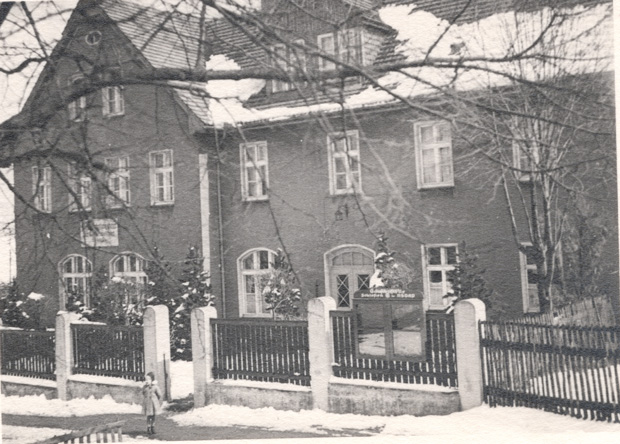
ABOVE: The Gaufilmstelle HQ in Silesia, Prussia.
BELOW: The relationship of the Gaufilmstelle to the German Film hierarchy is shown in the second panel of this organisational chart, copied from the pocket booklet "Instructions to the projectionist of the Main Branches of the film Gaupropaganda Offices of the NSDAP" found in our film book library.

The Mission of the Gaufilmstelle was also spelled out in 7 key points in the booklet, along with introductory remarks:
" Basics.
The propagation of the German people and the care of the population by means of propaganda films and good cultural and feature films, the latter predominantly in the so-called cinema-free locations, is carried out by the main branches of the NSDAP's propaganda offices.
The main film departments (Gaufilmstellen) are not commercial companies, but party departments with only propaganda and cultural tasks!
The head of the main film department (head of the Gau office) is the supervisor of all employees of his department in a disciplinary and political sense, the head of the "Gaupropagandaamt", technically the head of the "Hauptamt Film" of the Reich Propaganda Directorate.
The main film offices receive direct instructions from the "Hauptamt Film" of the Reich Propaganda Directorate about program design, film use and all technical matters.
The diverse tasks set for party film work are essentially structured as follows:
1. Education and instruction through propaganda films of the party and the state;
2. Distribution of the newsreel and the best cultural and feature films to bring joy, relaxation and distraction from everyday worries to the population;
3. Conducting youth film lessons together with the HJ and;
4. Implementation of the currently extensive Wehrmacht support;
5. Cooperation with training and public education offices and related special efforts;
6. Taking care of the foreign people's workers gathered in community camps and;
7. Use of party films in the cinemas.
While the distribution of party-owned propaganda and feature films is carried out directly by the main film department, the practical implementation of the tasks listed in 1 to 6 is primarily in the hands of the film projectionist at the main film department.
There are few areas of work with such a beautiful and satisfying, but also important, responsible task!"
-------
We have very scarce Gaufilmstelle publication issues from:
Der Gaufilmstelle Westfallen–Nord: Film–Nachrichten –Nr. 4 Mai 1939, Nr. 6 Juli 1939
Gaupropaganda–Leitung Hauptstelle Film Gau Hessen–Nassau: Partei und Film – Dezember 1938, Mai 1939
Gau Hessen–Nassau: Propaganda–Dienst – Nr.2 Februar 1943.
Film der Partei -Gau Ostmark – Nr.-3, 1.März 1938
We have 20 issues of the Gaufilmstelle Sachsen magazine Film & Foto which are from 1937/1938:

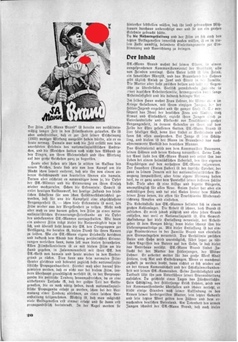
A Gaufilmstelle cinema ticket from Berlin:
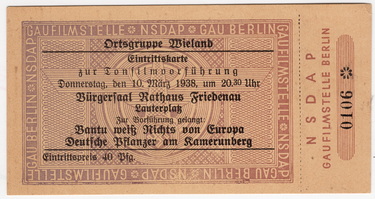
In the pre-war years, some foreign films, such as the Hollywood "Lives of a Bengal Lancer" starring Gary Cooper, were shown across the regional film distribution network. In this Gaufilmsttle Sachsen magazine article, readers are reminded that the Führer said that Germany must not isolate itself from the world, and at the recent International Film Congress (in Berlin) this film was praised.
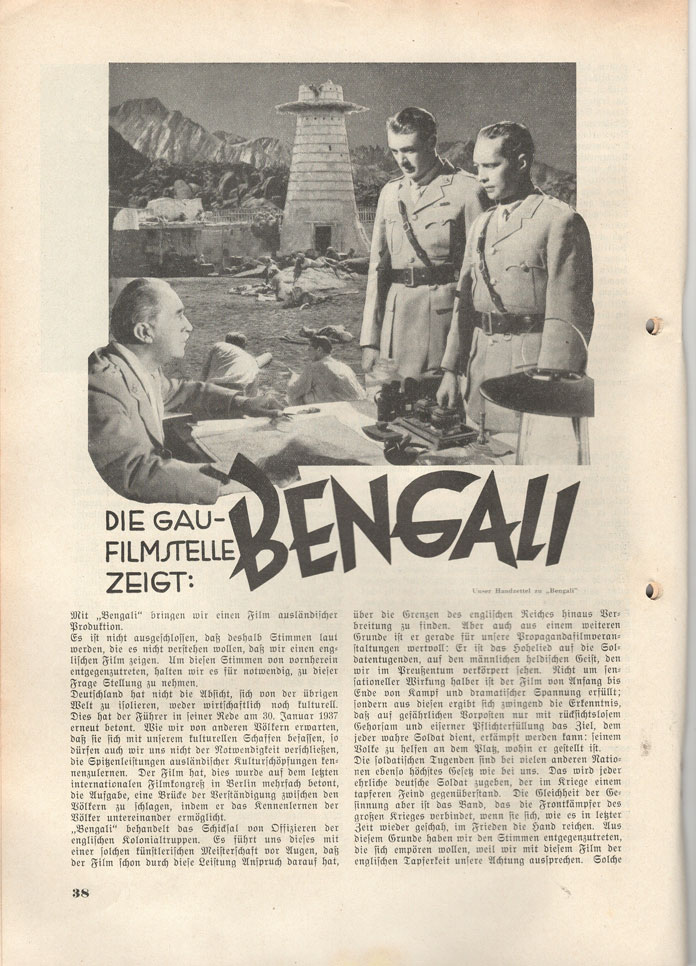
FILM HANDBILLS AND BROCHURES OF THE GAUFILMSTELLE
We have two dozen handbills circulated for specific cinemas across Germany for various propaganda films. Here are some examples:
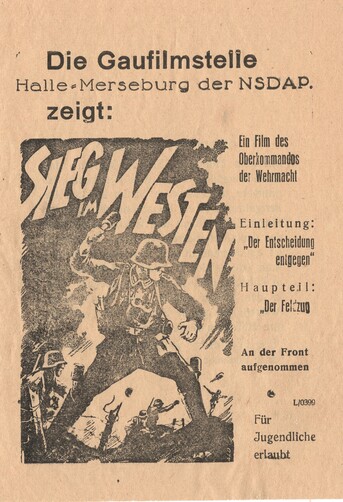
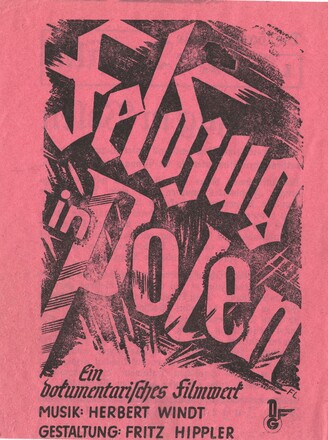
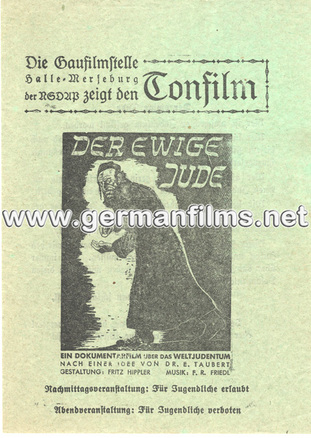
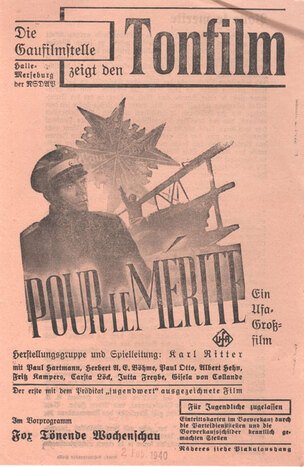
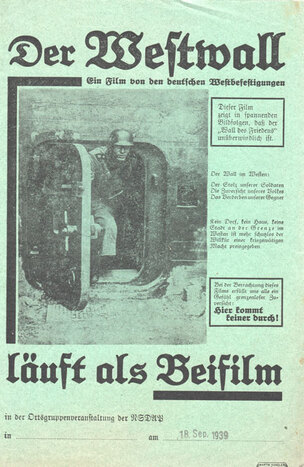
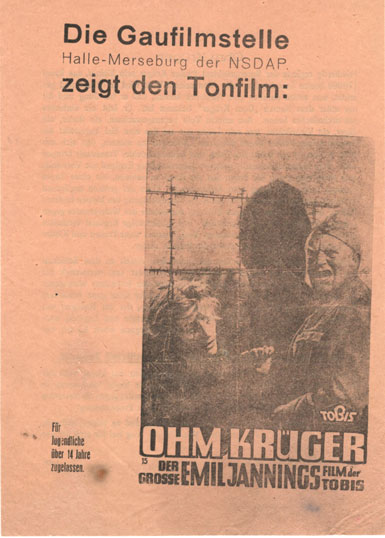
We have these original Gaufilmstelle posters:
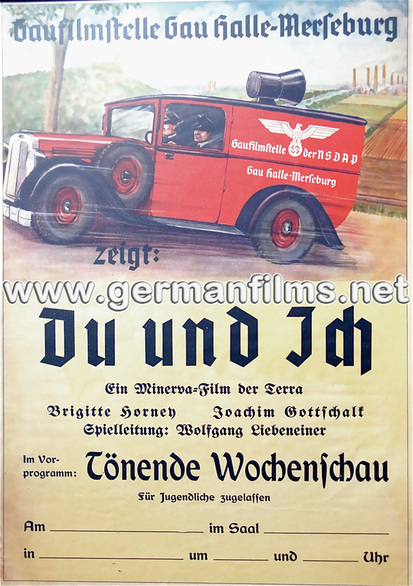
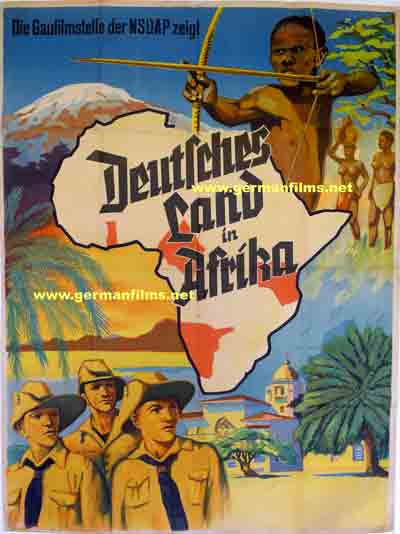
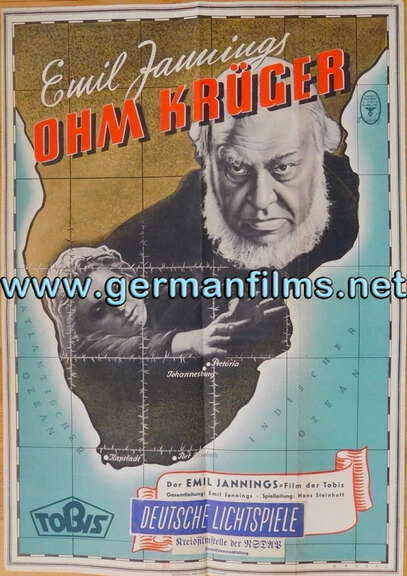
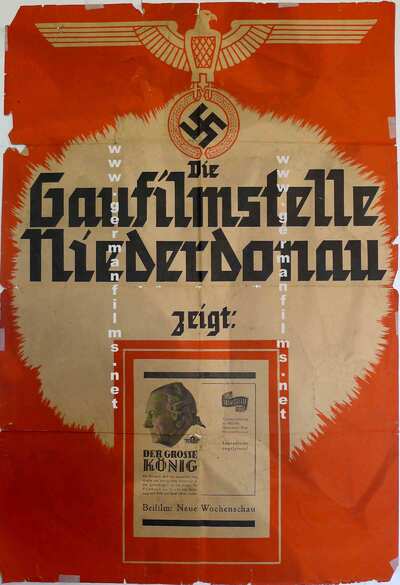

We also have the original Gaufilm Westmark (bordering France) film poster for the Hitler Youth film Der Marsch zum Führer. The link takes you to a special page on the film, its background, history, and rare stills and materials associated with it. It is the only known surviving poster for this film.
-------------------
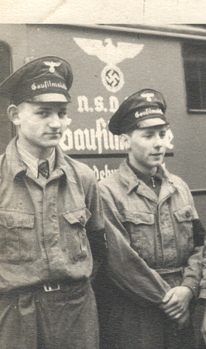 Film screenings in regional towns and villages were delivered by mobile cinema vans and trucks, which hauled movie projectors, sound systems, and screens with trained personnel to thousands of such places, and many hundreds of thousands of Germans were able to see films and newsreels annually, without having to travel to a major metropolitan city.
Film screenings in regional towns and villages were delivered by mobile cinema vans and trucks, which hauled movie projectors, sound systems, and screens with trained personnel to thousands of such places, and many hundreds of thousands of Germans were able to see films and newsreels annually, without having to travel to a major metropolitan city.
From our photographic collection:
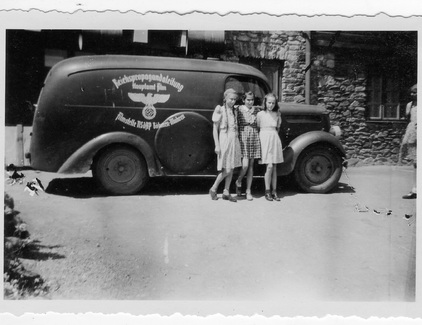

ABOVE 3 PHOTOS- The Gau Thüringen (Weimar district) mobile cinema trucks on the road. Note in the bottom photograph the installed record-player, which played military marches and the like prior to film screenings as audience members gathered, and also the 'Horst Wessel Lied' at the end of film screenings.
BELOW: photos from a Gaufilmstelle magazine in our Collection.
The heading reads: "Our strongest propaganda weapon – the large-screen film train " (i.e. film truck and trailer combination).

In the photo below, the projection trailer with its window is shown at left, and the sound truck to the right, with cabling for the loudspeakers to be placed in front of the movie screen, as well as a microphone set-up to allow speakers to address audiences before and after the cinema presentation.
In the photo below, the view inside the projector trailer.
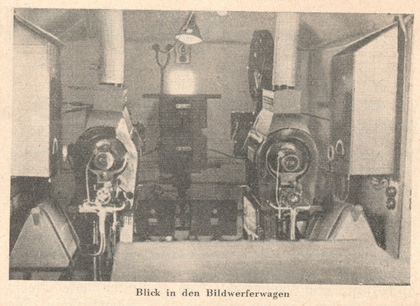
BELOW: In the issue of Film der Partei listed above, news that open air cinema screenings were held in Bayreuth, attended by 11,000 people. The propaganda film S A Mann Brand was watched by 5,000 audience members alone. It reports that this 'new form' of screenings in the summer months was enthusiastically supported. All up, there were 400 film screenings attended by 120,000 persons. In calendar year 1937 the magazine reported some 96,000 citizens were shown films by 400 mobile cinema truck visits inside the borders of Gau Sachsen. Some 120,000 people saw films inside cinema theatres. Some 350,000 children and students attended film showings. Some 33,000 Hitler Youth members attended 66 screenings of "state-political films" such as Karl Ritter's Operation Michael and his The Traitor. In total, just in one one Gau, no fewer than 967,400 persons attended films presented via the Gaufilmstelle Sachsen in the year 1937.

Further information on the film S A Mann Brand as well as it's Gaufilmstelle regional screenings in 1938, is available here.
BELOW: In the same issue, a page showing the schedule of the Tonfilmwagen or mobile cinema truck, which brought films to villages and hamlets. Note that the notorious documentary film Opfer der Vergangenheit / Victims of the Past, which promoted euthanasia for those suffering hereditary illness, was shown as a short film, along with the weekly newsreel, with the feature film Der lachende Dritte, across the Regensburg–Bayreuth area.
On April 4, 1937 a letter from Stabsleiter Hugo Fischer of the NSDAP Reichspropagandaleitung to all Gau leaders stated that the Führer wished to have Opfer der Vergangenheit shown in all Reich cinemas because of its importance. This included screenings in all Gau,- Kreis- and Orts- groups (i.e. down to the local level of film distribution.) The letter stated that Fischer was to be informed when the film would be screened the Gau leader's area. The first page of the letter, which is in the Bundesarchiv–Filmarchiv files:
Article on Opfer der Vergangenheit and a second film in a 1938 Gaufilmstelle magazine published for Gaufilmstelle staff:
Opfer der Vergangenheit was still being shown a year later in some areas:
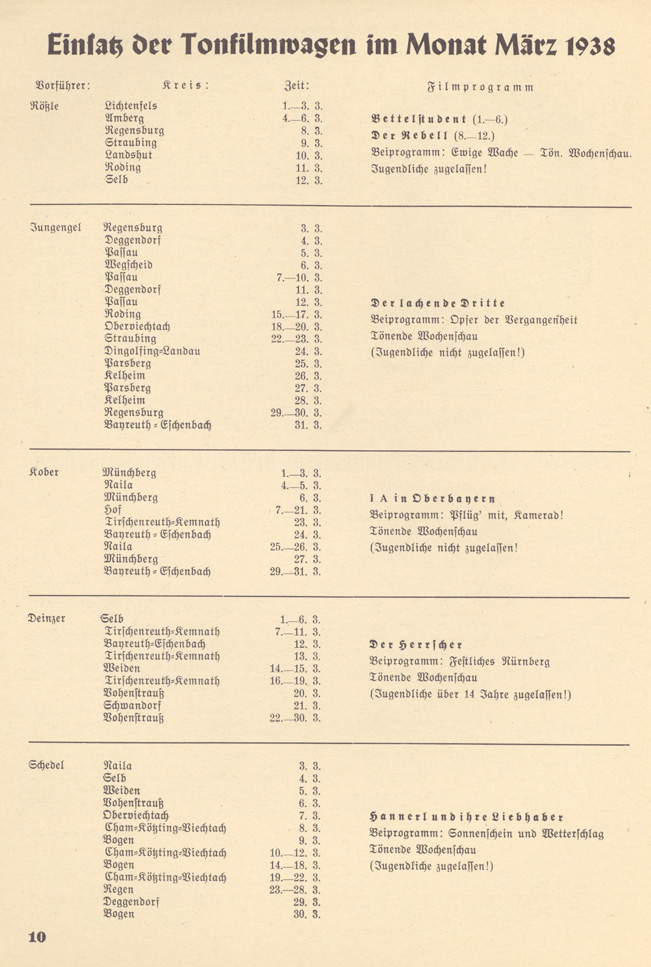
BELOW: The feature films beiong shown in the regions of Gau Hesse-Nassau (The greater Frankfurt/Main geographical district in February 1943:
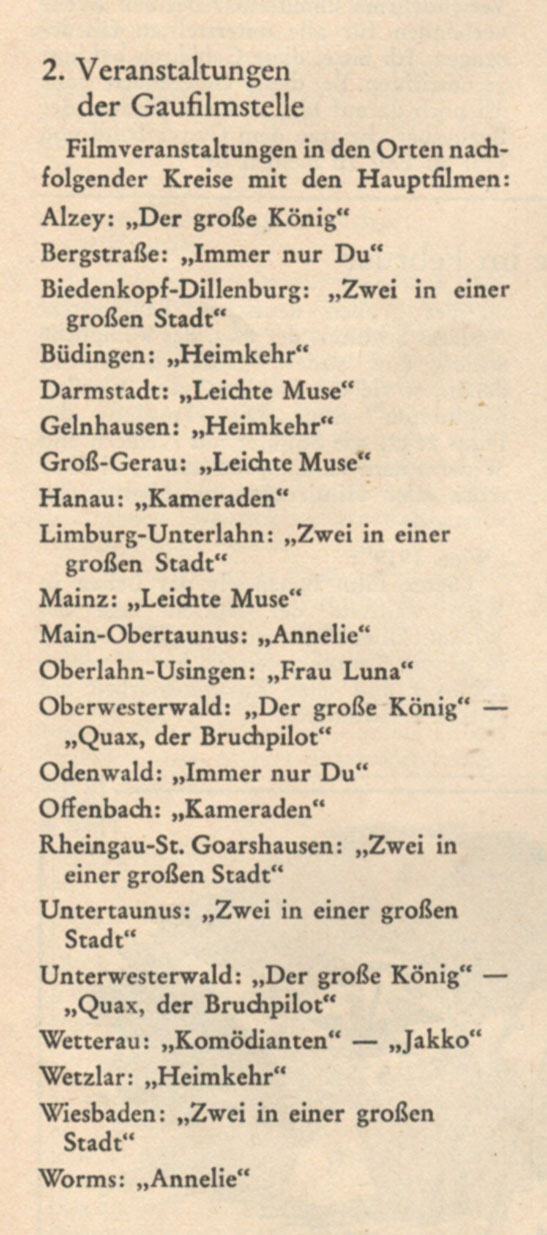
In July 2020 we acquired probably the only surviving car pennant for a high–ranking official of the Gaufilmstelle. It was offered for sale by a militaria website in Germany. It is the pennant from Gau Westfalen–Nord (an administrative division of Nazi Germany encompassing the Free State of Lippe, Free State of Schaumburg-Lippe and the northern half of the Prussian province of Westphalia between 1933 and 1945.) This is an incredibly rare museum piece which we were able to purchase after having missed the opportunity to do so some years ago when it was first auctioned in the USA. Our second chance simply could not be passed up.
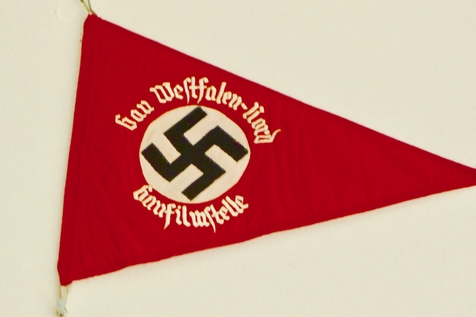
Provision of films to the Wehrmacht in the Occupied USSR though to 1944 fell to the Reichspropagandaleitung (RPL) in a very similar method to the ways used by the Gaufilmstelle in the Greater German Reich. The RPL had its own mobile cinema trucks in the East, as per this photo from the film magazine Der Deutsche Film. Note the vehicle being towed through Soviet mud en route to a German base.

BELOW, a PK cameraman's press photo dated 30 June 1943 taken on the Ostfront, showing a Gaufilmstelle projectionist wearing an NSKK (Motor Corps) uniform as he examines a 35mm film print. The press photo caption states that he brings 90 minutes of fun and relaxation to the soldiers on the East Front.
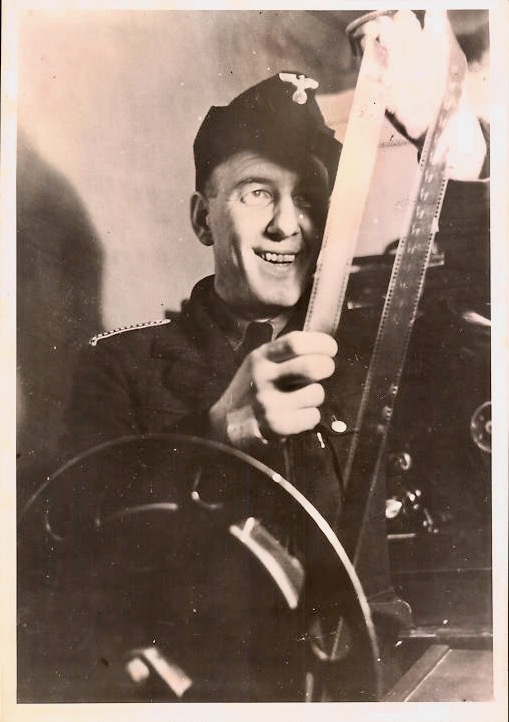
BELOW, From a 1937 issue of a Gaufilmstelle Sachsen magazine in our Collection, the announcement of the new Gaufilmstlle poster for the Riefenstahl 1934 Nürnberg Party Day film Triumph des Willens:
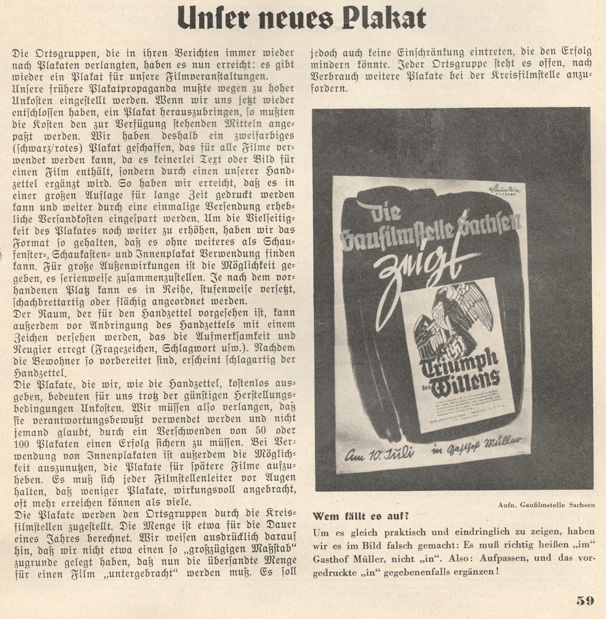
-------------------

